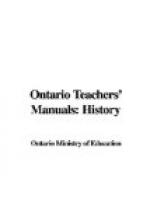2. In history: (a) Some information about the growth of the Empire; for example, how and when Canada, Australia, New Zealand, South Africa, or any other part of the Empire was added; (b) Comparison of the size of the British Empire with that of any earlier Empire, such as the Persian, Greek, or Roman; (c) The growth of Great Britain’s commercial and naval supremacy, on what it is founded, what danger there is of losing it, etc.; (d) Interpretation of the Union Jack, or of the Canadian ensign.
3. In geography: (a) Story of the “All-Red” route, or of the “All-Red” cable—explain the meaning of “All-Red” by reference to the map; (b) “The sun never sets on the British flag.” Make this clear by having pupils notice on the map that there are red spots, showing British territory, on or not very far from every meridian line; British ships, too, are in every part of the ocean; (c) Compare the population and area of Great Britain, Canada, Australia, the United States, Germany, France, etc.
4. In arithmetic: The pupils may discover how many people there are to the square mile in these countries; they may be asked to work out the population Canada would have if she were as densely populated as England, as the United States, as Germany, etc.; how fast did the population of the United States increase in the first century after the Revolution; what will the population of Canada be in fifty years, if it increases as rapidly as the population of the United States in the last fifty, etc.; at the present rate of increase, when will Canada catch up to Great Britain? When surpass her? Indicate thus the possible position and power of Canada in the not distant future, in order to deepen the sense of responsibility for the use made of our opportunities. (Let the pupils search for as much of the material needed for these calculations as they can find in their text-books.)
5. In composition: Subjects may be given for either oral or written composition; they may be reproductions of some of the exercises mentioned above, or may be on topics connected with them.
6. In drawing: Pupils may draw the flag, or any map needed above.
TYPE LESSONS
FORM IV
INTRODUCTORY
As described in the details of method for Form IV (see p. 28), the ideal method of teaching in this Form is the oral method, which means not only the narration of the story, but the presentation to the pupils of problems connected with the lesson that the experiences of the class may help to solve. The full narration here of the lessons selected would be like doing over again the work of the text-book; accordingly, in the majority of the lessons, a topical analysis is all that is given. The value of a topical analysis is that it emphasizes the principal




